Bukhara: Exploring Unique Historic Sights and Timeless Charm
This visit guide covers the sights of the old Silk Road city of Bukhara in Uzbekistan.
A trip to Bukhara
After a swift and comfortable journey on the Afrosiyob high-speed train from Samarkand to Bukhara, I found myself at the next destination on my Uzbekistan itinerary.
I would spend two days in Bukhara and was immensely looking forward to exploring the city’s historic sights.
From the train station, I took a taxi to my boutique hotel at the southern edge of the city centre.
Having checked in and dropped off my baggage, I set off straight away for a walk around town.

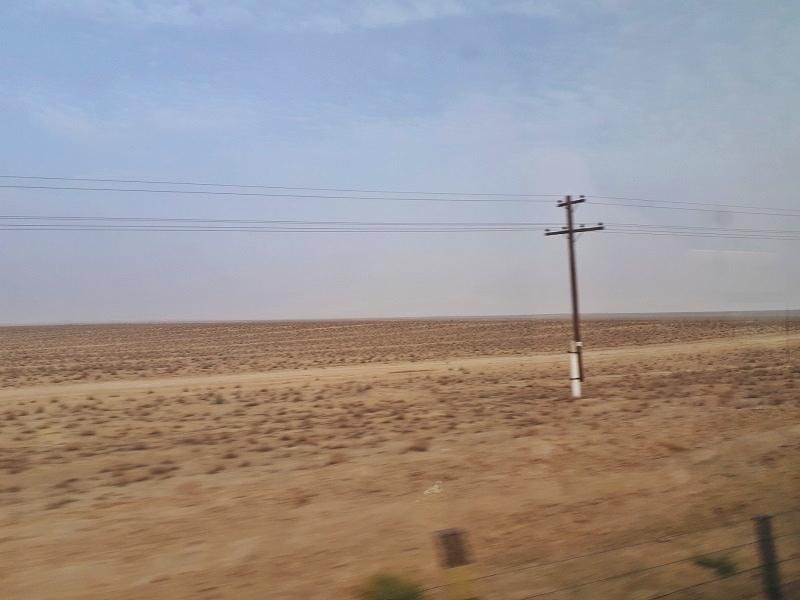

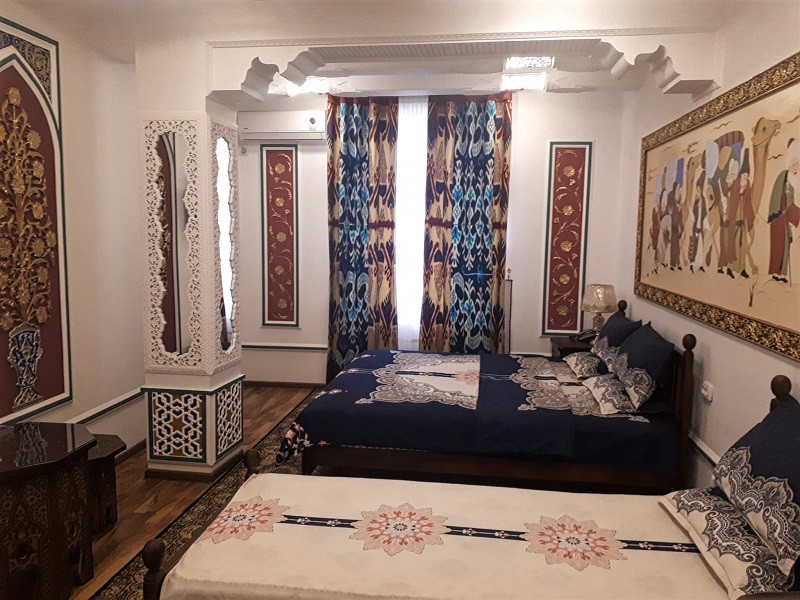
First impressions of Bukhara
Coming from Samarkand, I immediately felt that Bukhara had a completely different vibe altogether even though both cities have common roots as trade posts on the Silk Road.
While walking along the muddy streets from my hotel to the city centre of Bukhara, it was as though I had been transported back in time by a century or two.
The houses all exhibited similar shades of grey and brown, featuring a rather ordinary design.
The vehicles on the roads were predominantly relics from the Soviet era, and the locals maintained a discreet presence as they walked the streets.
Samarkand, as the ancient capital of the grand Timurid empire, projected a more worldly and sophisticated ambiance, while Bukhara, surrounded by inhospitable desert terrain, carried a certain conservative and introspective character owing to its history as an oasis town.
While Bukhara undeniably boasts some stunning historical sights, including some beautiful mosques and madrassas akin to those in Samarkand as I would come to realise later in the day, their architectural style appeared less elaborate in style.
However, this characteristic isn’t negative at all – it rather enhances Bukhara’s authenticity as it makes you feel like you’re genuinely strolling through a unique historic place where the cityscape and character blend seamlessly.


Abandoned madrassas
Although I hadn’t yet reached the heart of the city and hadn’t come across any of Bukhara’s main attractions, I was already thoroughly enjoying my walk through the neighbourhood just south of the city centre.
In this part of the city you can find some abandoned madrassas and mausoleums such as the highly derelict Goziyon Madrassa and the crumbling Turki Jandi Mausoleum.
Sadly, these historic buildings are in a bit of a sorry state, although they still have some raw beauty and you don’t need much imagination to picture how they must have looked like a century or two ago.
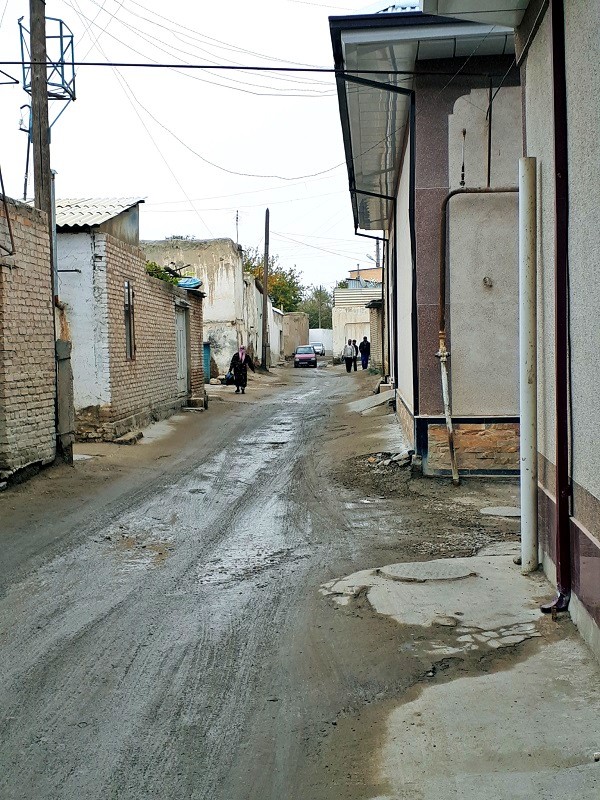
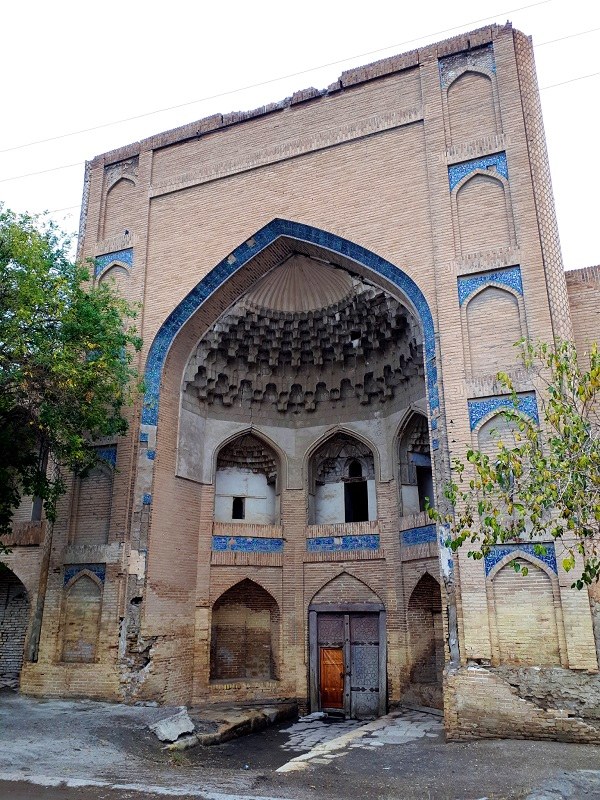
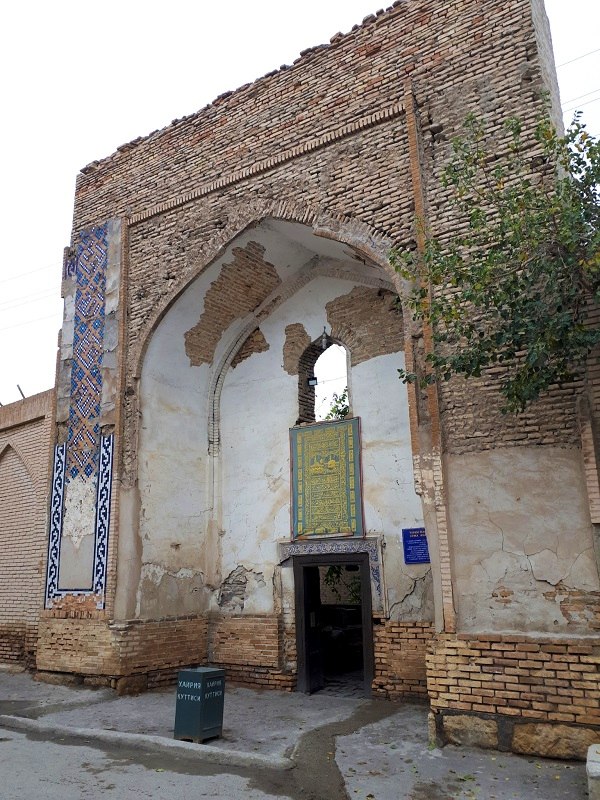
Lyabi-Hauz
The heart of Bukhara is arguably Lyabi-Hauz, a square surrounding a large rectangular pool that was built in the year 1620.
In the immediate surroundings, you can also see a picturesque little canal running parallel along a cobblestoned street.
The name Lyabi-Hauz means “by the pool”, with the word ‘Hauz’ being derived from the Persian word ‘howz’ meaning ‘pool’.
A howz was included in traditional Persian mansions for both aesthetic reasons and bathing purposes.
However, these pools were also constructed in public squares and outside mosques, where they were used for ablutions before prayer times.
Bukhara used to feature many more pools and canals in the city, but as the stagnant water was also prone to the proliferation of diseases such as the plague, most of these water bodies were dredged by the communists when Uzbekistan was part of the Soviet Union.
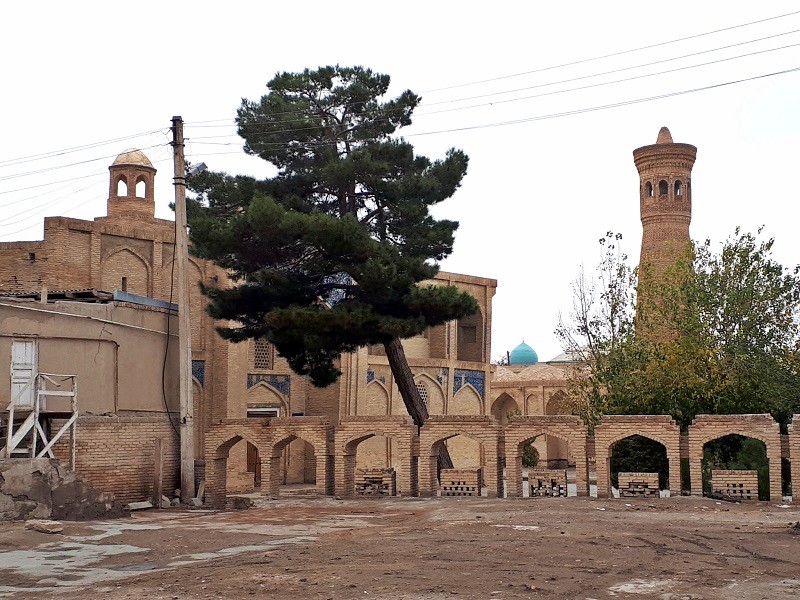
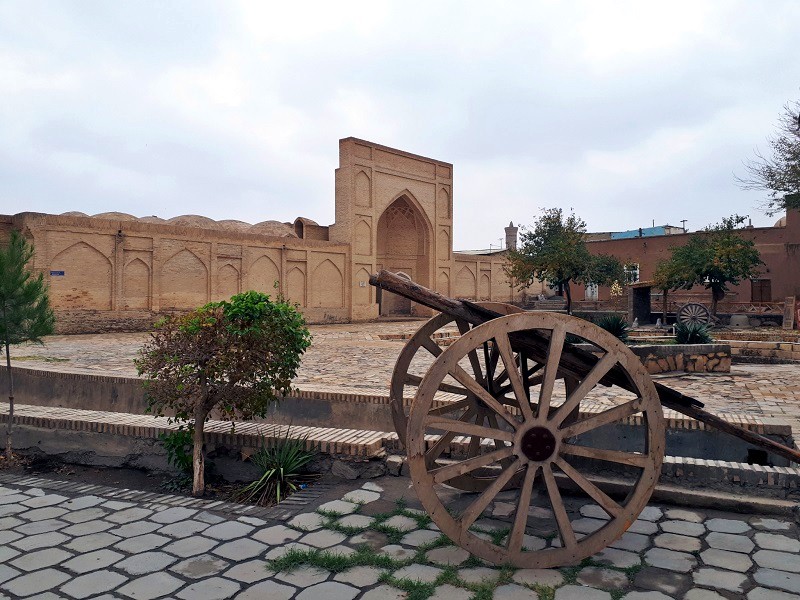



Buildings around Lyabi-Hauz
Directly around Lyabi-Hauz you can find a couple of important Bukhara sights.
On the northern side of Lyabi-Hauz stands the Kukeldash Madrassa.
Constructed in the mid-16th century, the Kukeldadsh Madrassa is the oldest within the architectural ensemble surrounding Lyabi-Hauz.
This madrassa (Islamic school) features two floors of dormitory cells and classrooms arranged around an inner courtyard.
In later times, the building was also used as a caravanserai (traveller’s inn) as well as a fortress.
Although it’s enjoyable to explore this madrassa, it doesn’t quite match the beauty of the ones at Samarkand’s Registan.
More interesting in my opinion are the two historic buildings on the western and eastern sides of Lyabi-Hauz, both of which are named after Nadir Divan-begi.
Nadir Divan-begi was a vizier (high-ranking official) and second-most powerful man in the city after Imam Quli Khan, who was the third ruler of the Bukhara Khanate in the early 17th century.
On the west side of the Lyabi-Hauz pond you can find the Nadir Divan-begi Khanqah.
A khanqah or kanaka is a type of building or complex used for Sufi Islamic gatherings and rituals.
Opposite the khanqah on the eastern side of Lyabi-Hauz you can find the Nadir Divan-begi Madrassa, which in my opinion is the most beautiful of the three buildings.
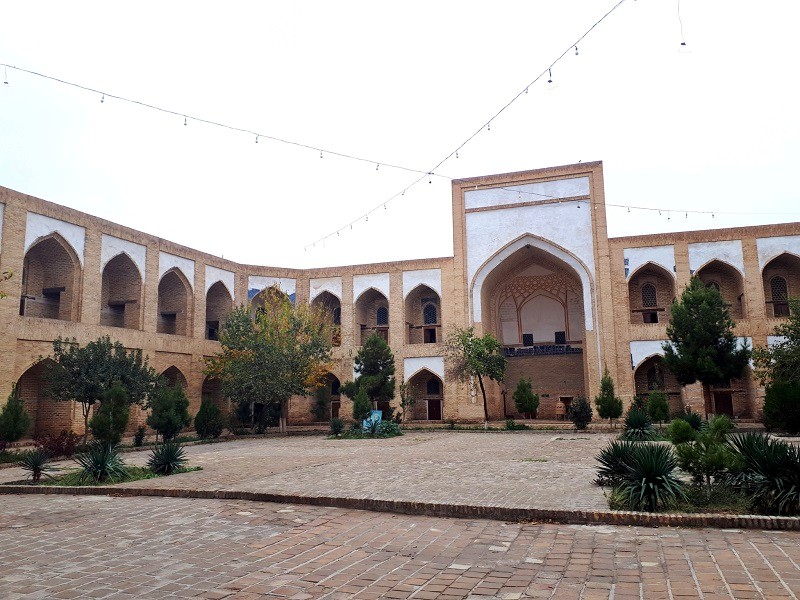


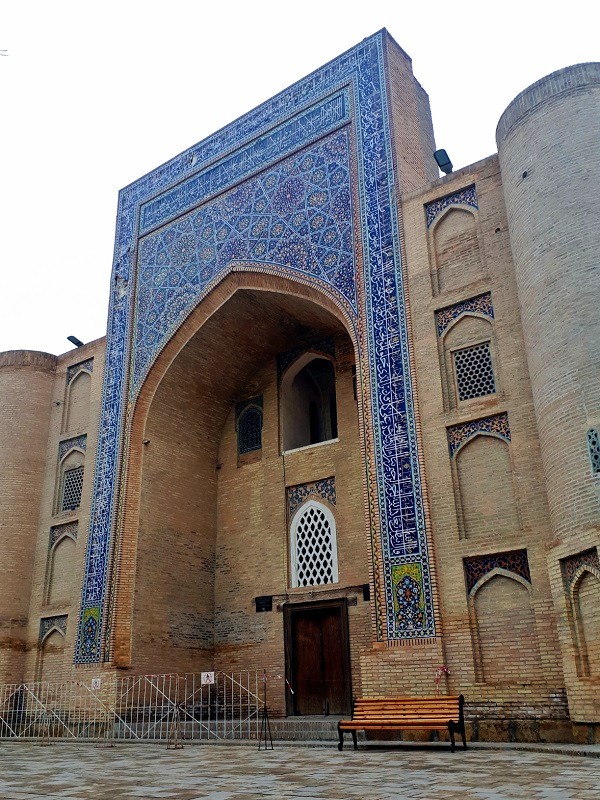


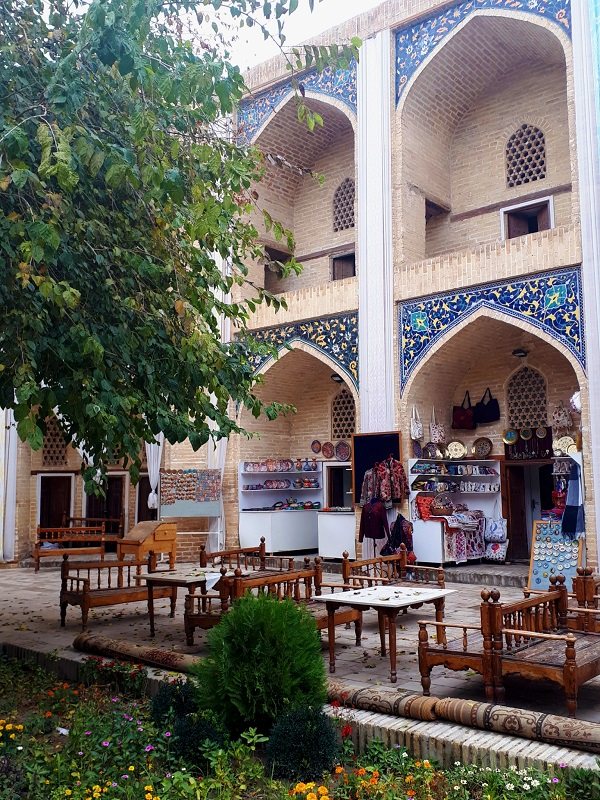
Lunch
As lunchtime drew near and my hunger and thirst grew, I made the choice to sit at the only restaurant providing outdoor seating right next to the Lyabi-Hauz pool as the view from the terrace was simply unbeatable.
Called Labi Hovuz, this restaurant didn’t disappoint.
Given that the food and service proved to be excellent (and they offered cheap draught beer as well), it even became my go-to spot for meals during my time in Bukhara.
For my lunch, I began with Kuza shurva, an Uzbek soup cooked in a clay pot, filled with meat, potatoes, carrots and various other vegetables.
For my main course, I selected laghman, a dish comprising pulled noodles, meat, and vegetables.
Laghman is a Central Asian staple and these noodles can be had both in dry form on a plate (which I had this time) as well as in a wet form in a bowl, more akin to a soup.
Given that native Turkic words don’t start with the letter ‘L’ and laghman therefore is loanword to the Uzbek language, the dish likely originated from China.
For the soup, laghman and two beers, I paid only around $7, which was great value considering the prime location of the restaurant.
To top off the great dining experience, I even had a super cute cat keeping me company at my table.

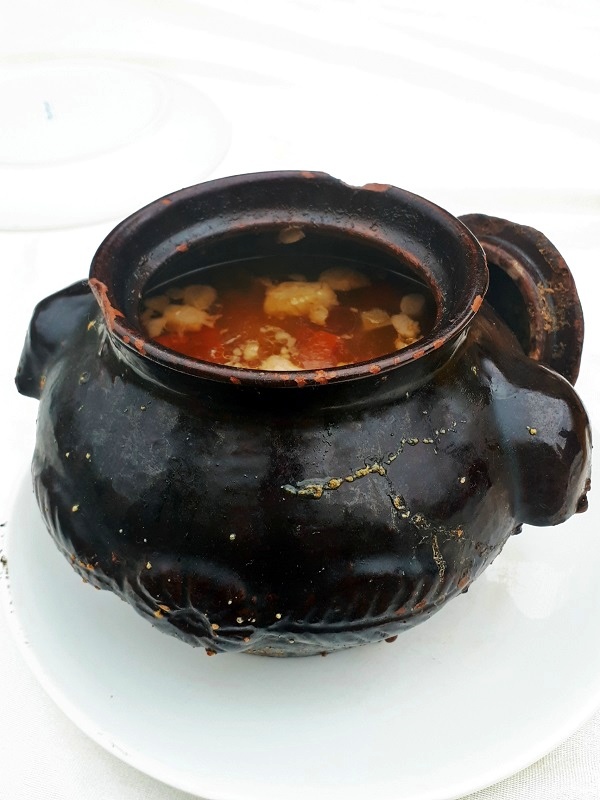


Bazaars
After the tasty lunch I continued my exploration of Bukhara with a visit to the city’s historic bazaar.
The Bukhara bazaar is located inside a series of brick-built domes from the 16th century, which are collectively known as the trading domes.
Although you’ll mostly find souvenir shops inside these domes, historically the offerings were much more varied.
The Toki Zargaron dome translates to Dome of the Jewellers and in the old days used to be home to jewellers and goldsmiths.
Similarly, the Toki Sarrafon dome also derived its name from the trade conducted within, as the Persian word “sarraf” means moneychanger and this dome therefore used to house the city’s moneychangers.

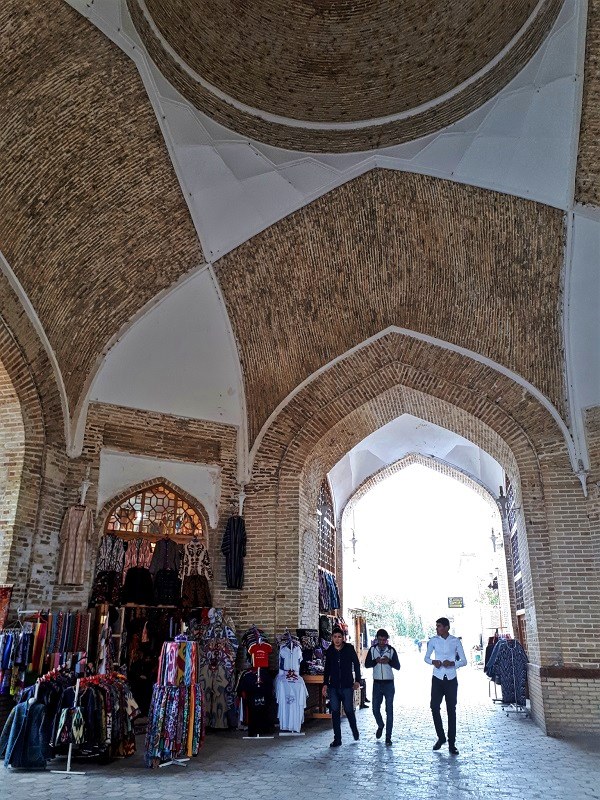




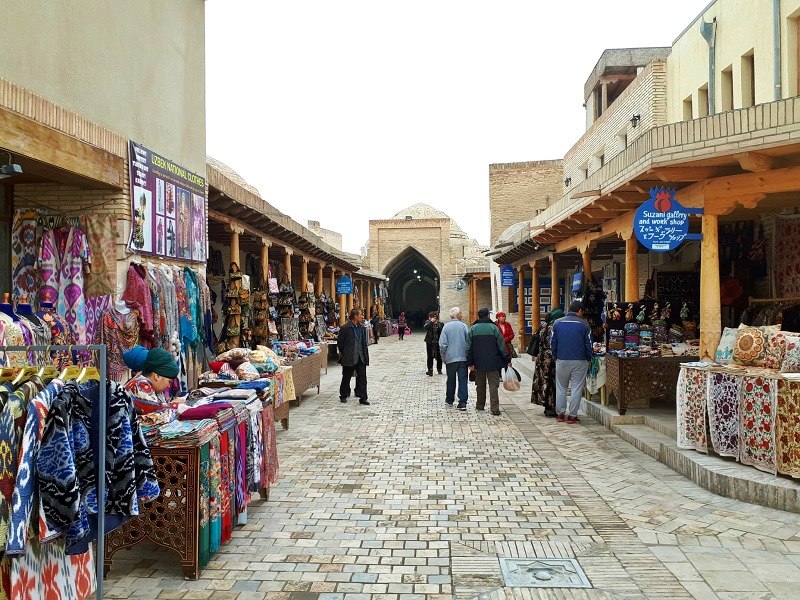

Char Minar
Having explored some of the bazaars, I walked to the east of Bukhara’s centre to visit a rather unusual sight.
In this part of the city you can find the Char Minar, which translates to “four minarets” in Persian.
The Char Minar used to function as the gatehouse of a madrassa, which was unfortunately demolished.
In case you are wondering about all the Persian words so far: During its history, Bukhara has been ruled by both Persian and Turkic dynasties.
In the present day, it’s actually Tajik (a Persian language) and not Uzbek (a Turkic language) that is the predominant spoken language within Bukhara.
For political reasons, the official data from the Government of Uzbekistan does however downplay the number of ethnic Tajiks by simply categorising them as Uzbeks.

Ulughbek Madrassa
Following my visit to the Char Minar, I retraced my steps to Lyabi-Hauz and headed towards the north-eastern part of Bukhara’s city centre, where the most important sights are located.
One of these sights is the Ulughbek Madrassa built in 1417, one of the few remaining sights in Bukhara from the Timurid Era.
Named after Timur’s grandson Ulughbek, this madrassa boasts exquisite tilework on its exterior and features an impressive entrance portal.




Abdul Aziz Khan Madrassa
Directly across from Ulughbek Madrassa, you’ll come across another historic madrassa, namely Abdul Aziz Khan Madrassa.
Constructed in 1652, this madrassa features an even more stunning façade, adorned with highly intricate tilework and other ornamental details.
While the ornamental artworks on the dormitory cells, schoolrooms and mosques surrounding the inner courtyard are somewhat dilapidated, the madrassa remains an incredibly impressive sight.
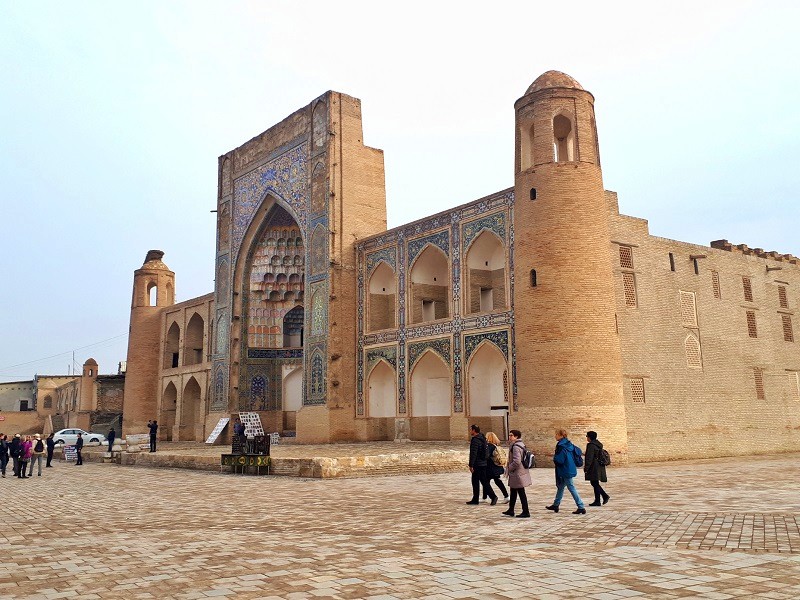



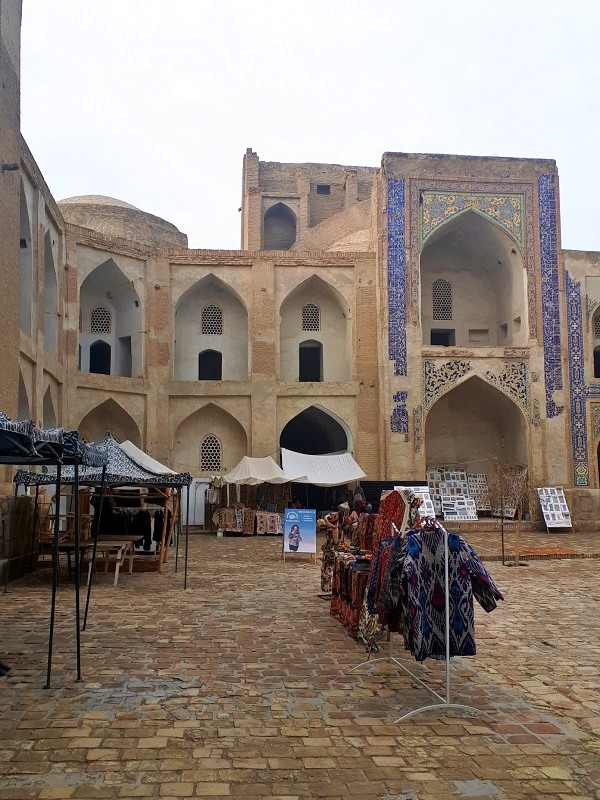

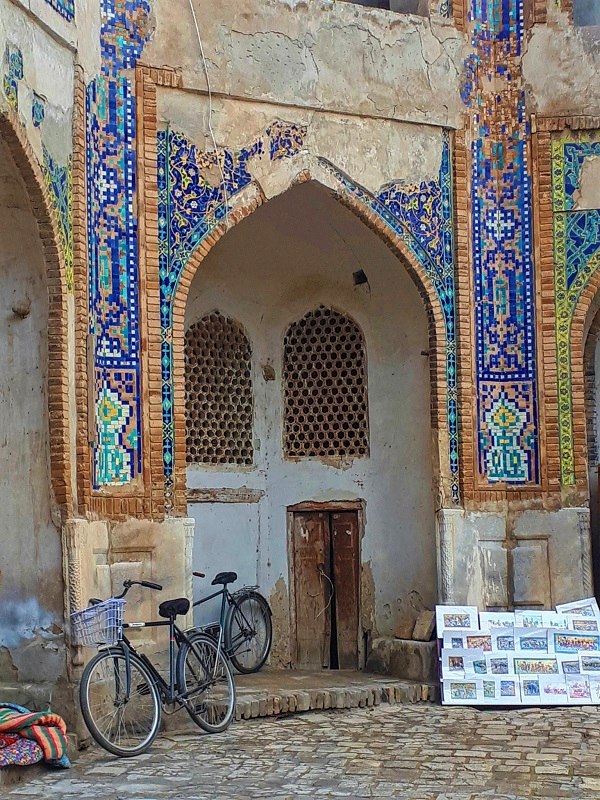
Po-i-Kalyan and the Mir-i-Arab Madrassa
Bukhara’s most stunning structures constitute an ensemble referred to as the Po-i-Kalyan or Poi Kalon.
This complex, which translates to “At the Foot of the Great One,” comprises the Mir-i-Arab Madrassa, the Kalon Mosque and the Kalon Minaret.
The 16th century Mir-i-Arab Madrassa must be one of Bukhara’s finest buildings with its impressive entrance portal and stunning azure blue dome.
Mir-i-Arab Madrassa is named after a Yemeni sheikh who held significant spiritual influence over Bukhara’s ruler, Ubaidullah Khan, and both are buried within this complex.
Unfortunately, tourists can’t enter this madrassa, but you can still get a quick peek of the inner courtyard through the gate.
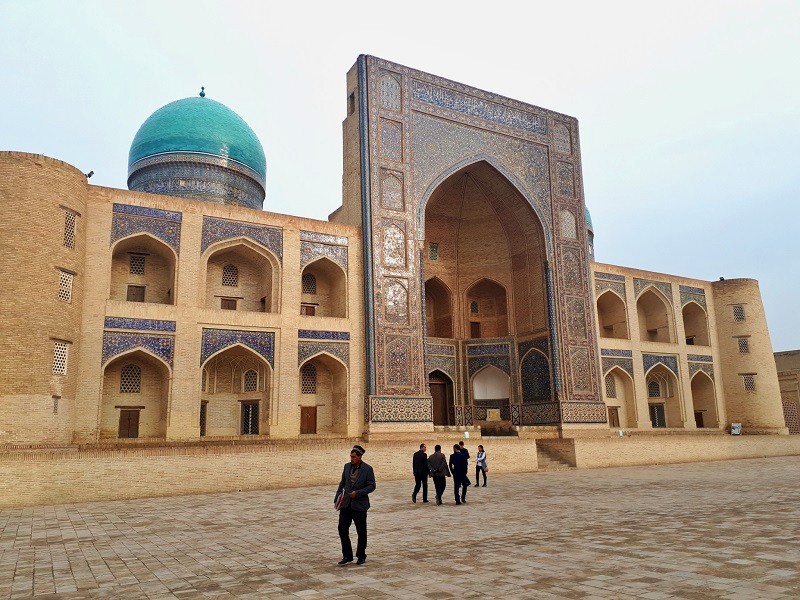
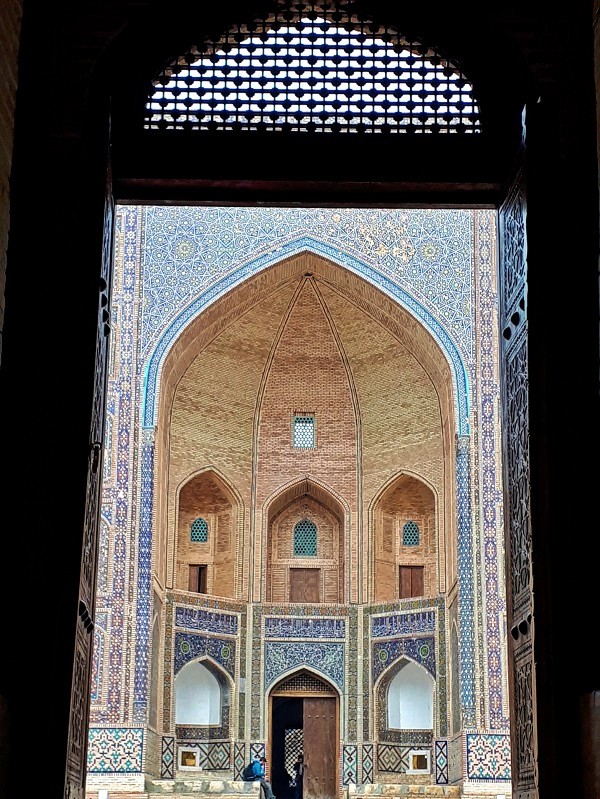
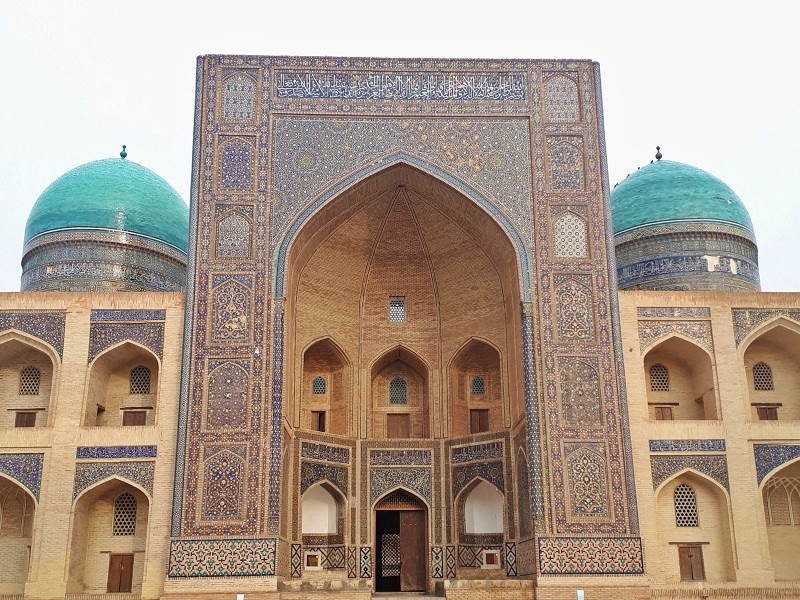
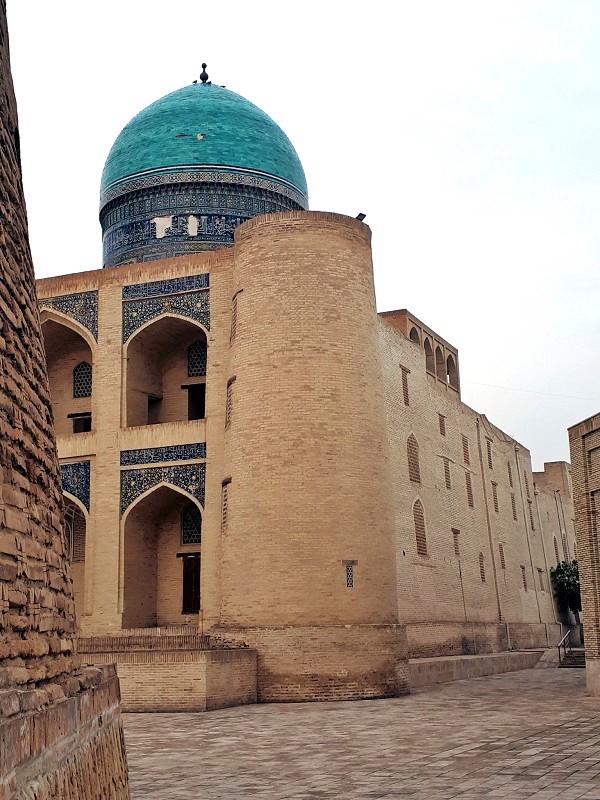



Kalon Mosque
Fortunately, you can visit what is arguably the most impressive sight of Bukhara: The Kalon Mosque.
The Kalon Mosque, which is also known as the Kalan Mosque or Kalyan Mosque, traces its origins back to the 12th century.
Sadly, the original mosque was razed to the ground by no-one else than Genghis Khan in 1220, although the great Mongol conqueror ordered the minaret to be spared from destruction as he was impressed by the structure.
The mosque itself was reconstructed in the 16th century during the reign of Ubaidullah Khan.
In the Soviet era, the mosque was repurposed as a warehouse for storing goods, but it regained its original religious function after Uzbekistan gained independence.



Inside the Kalon Mosque
The front entrance of the Kalon Mosque is surprisingly modest compared to its absolutely stunning interior.
As you enter the mosque, a striking dome-topped building with an octagonal kiosk in front of it comes into view at the far end of the inner courtyard.
This is the western iwan, which houses a mihrab inside – a half-circular niche that points towards the qibla, indicating the direction of the Kaaba in Mecca that Muslims have to face during prayer.
An iwan is a distinctive architectural feature in Islamic buildings, characterised by a vaulted or rectangular space that is enclosed on three sides and open on one side, often serving as an entrance portal.
Iwans adorn all four sides of the inner courtyard of the Kalon Mosque, including the eastern side through which you would have entered the mosque.
Encircling the courtyard is a spacious hypostyle hall adorned with hundreds of white arches, which functions as a covered praying area.
The mosque’s astonishing beauty makes it highly rewarding to take a leisurely stroll around the complex, as from each side you’ll get an entirely different perspective of the fabulous surroundings.







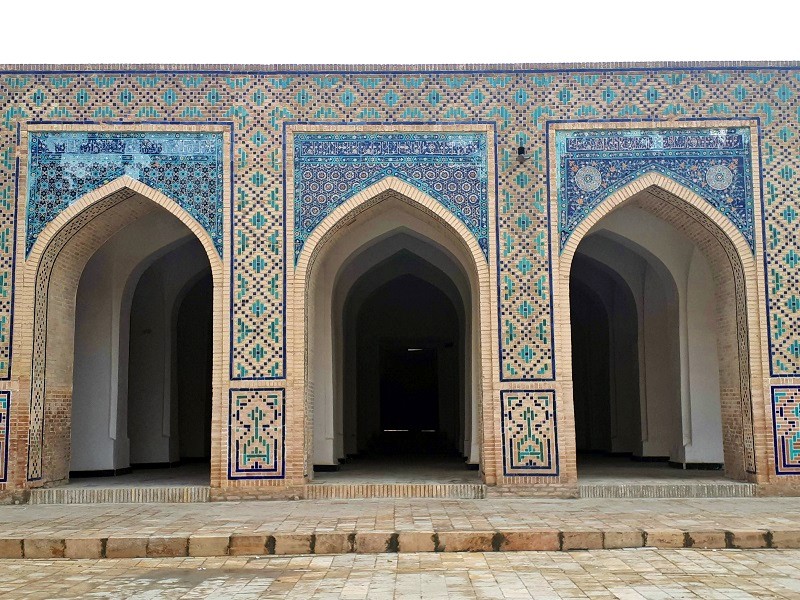
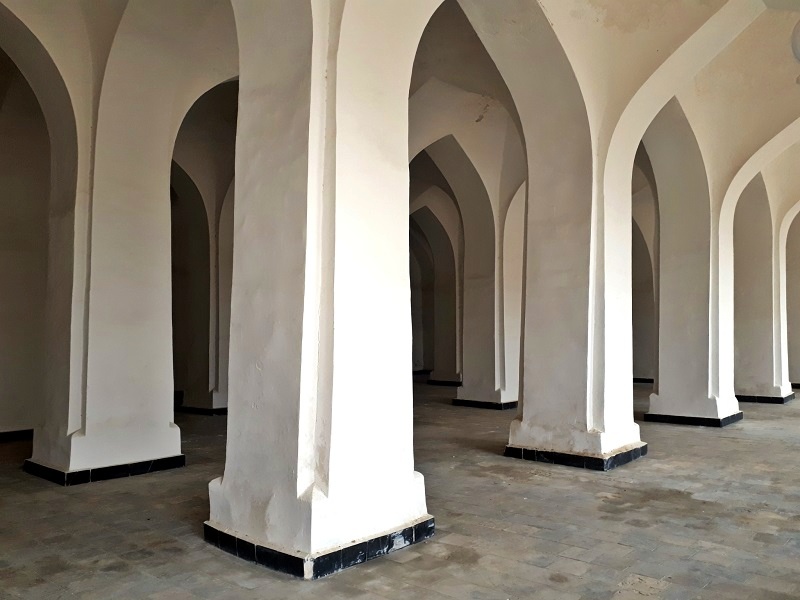


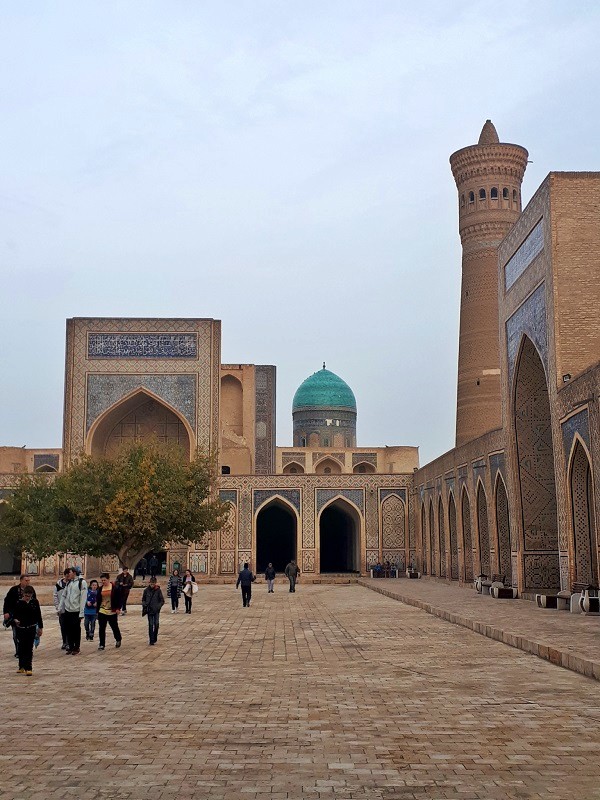

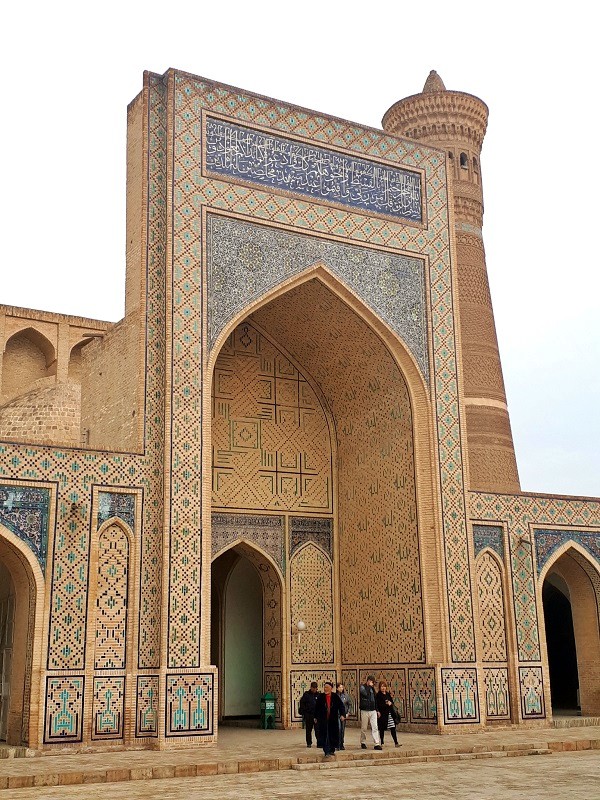

Evening walk
As the sun was slowly setting, I wandered a bit more through the picturesque streets around the Kalon Mosque.
I ended a fantastic first day in Bukhara with some more yummy Uzbek food at a local restaurant, the name of which unfortunately slipped my mind.
I couldn’t resist smoking some nargilah (or qalyan to use the Persian term) and having some tea after the meal.


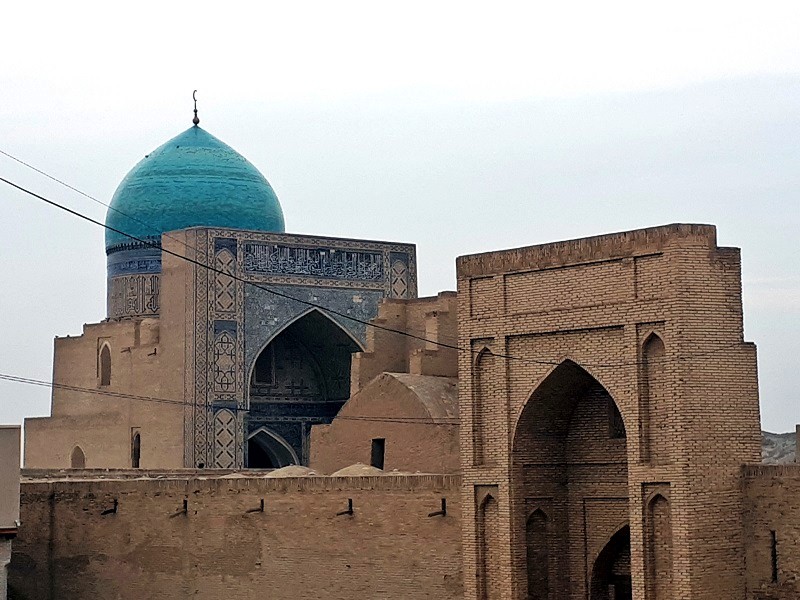

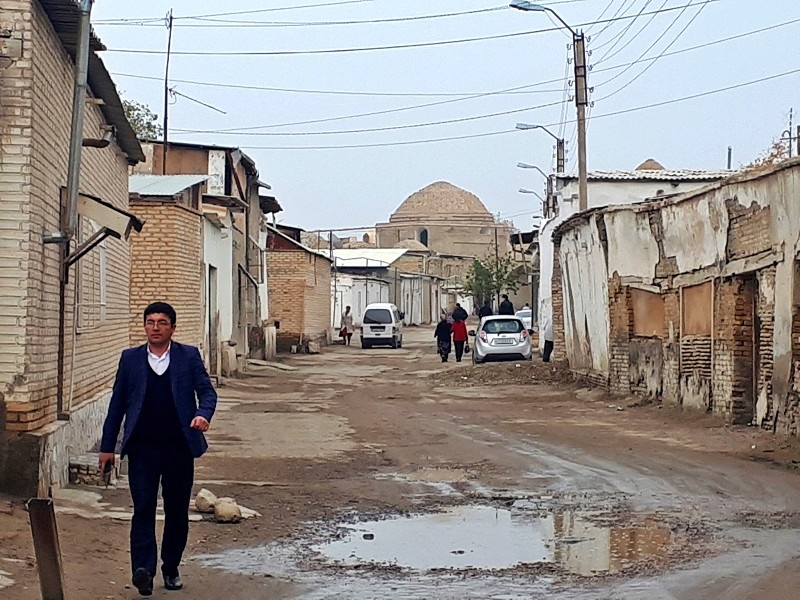
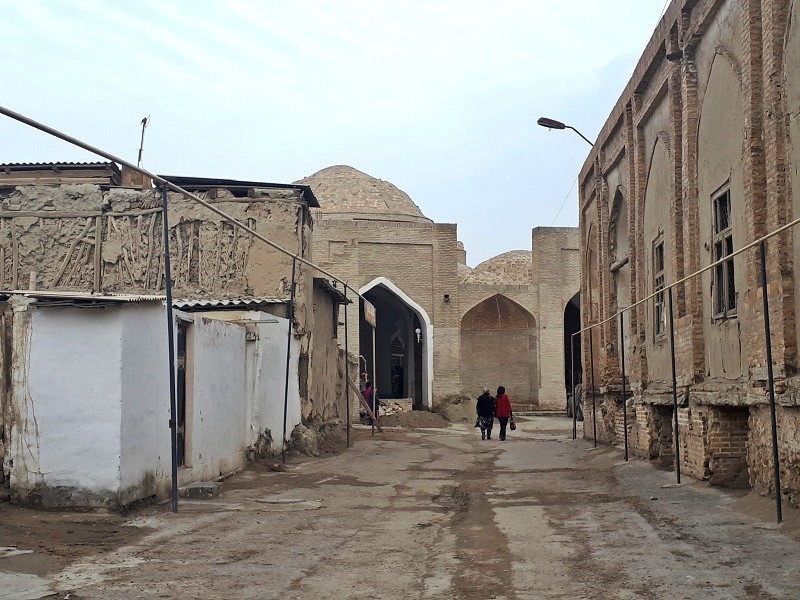

Bukhara, day 2
The morning of my second day in Bukhara started with a delicious breakfast featuring eggs, pancakes, and an abundance of fresh local produce, reminiscent of the meals I had at my hotel in Samarkand during the previous nights.
There were still some major sights left for me to explore in Bukhara, with the Ark being the most prominent among them.
It was a leisurely 40-50 minute walk to reach the Ark from my hotel.
As the walk took me along many of the sights I had visited the day before, it certainly was a scenic stroll.
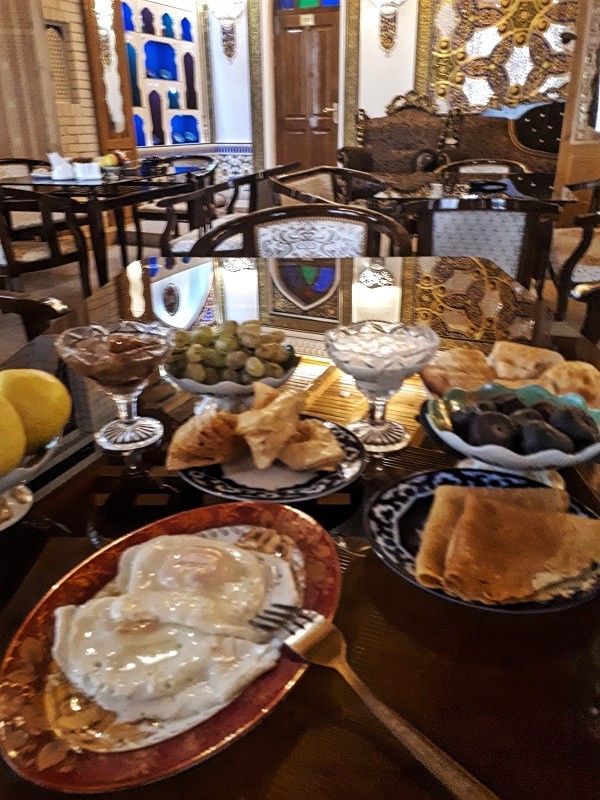

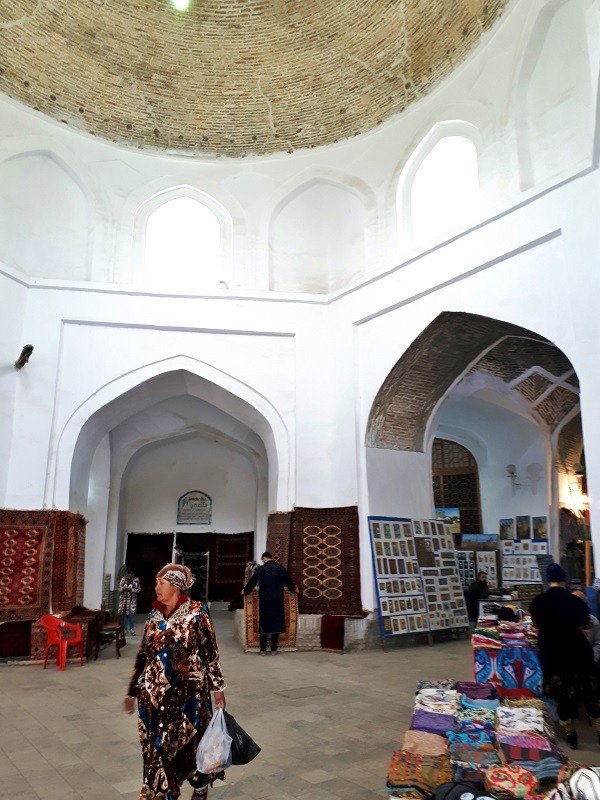

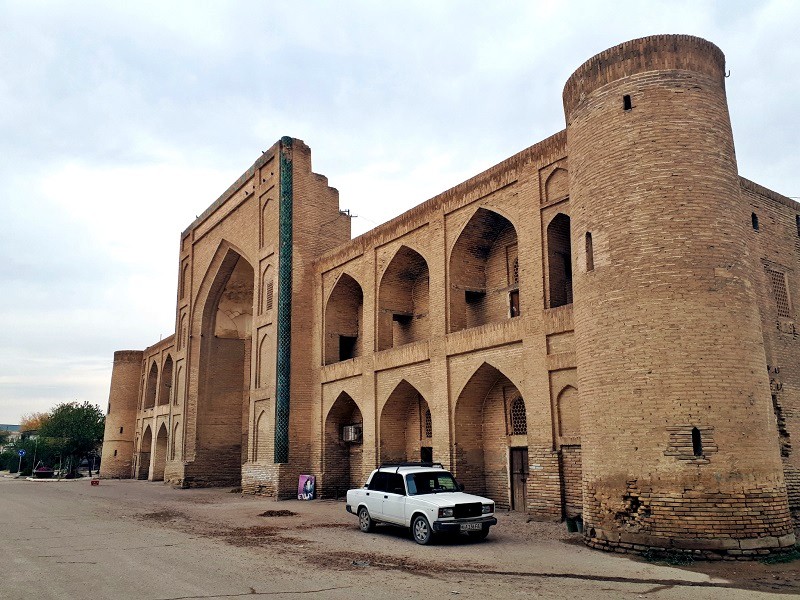
Ark of Bukhara
The Ark of Bukhara is the formidable fortress where the great Emirs of Bukhara once held court.
With its imposing earthen walls, the ark towers above the rest of the old town of Bukhara and indeed feels like it was the place of power in the past.
This royal fortress traces its origins back to the 5th century and was used all the way until 1920 when the Red Army conquered Bukhara.
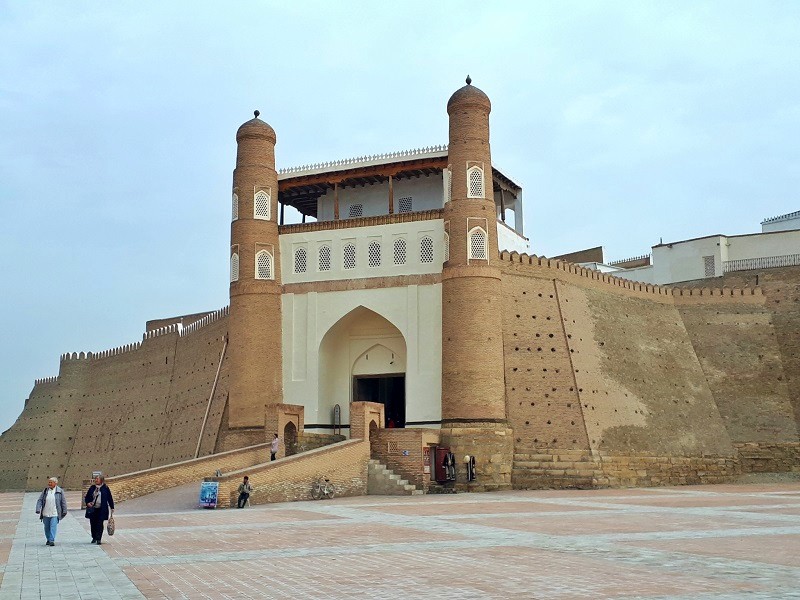
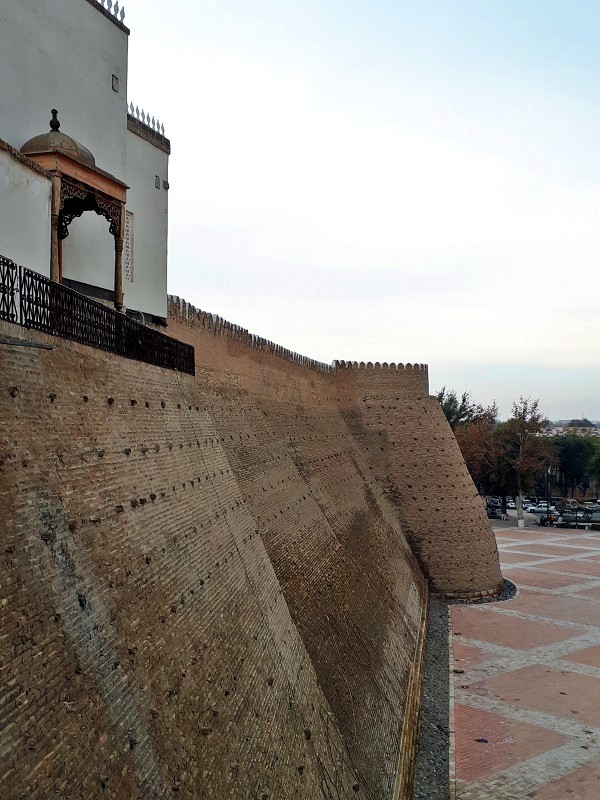
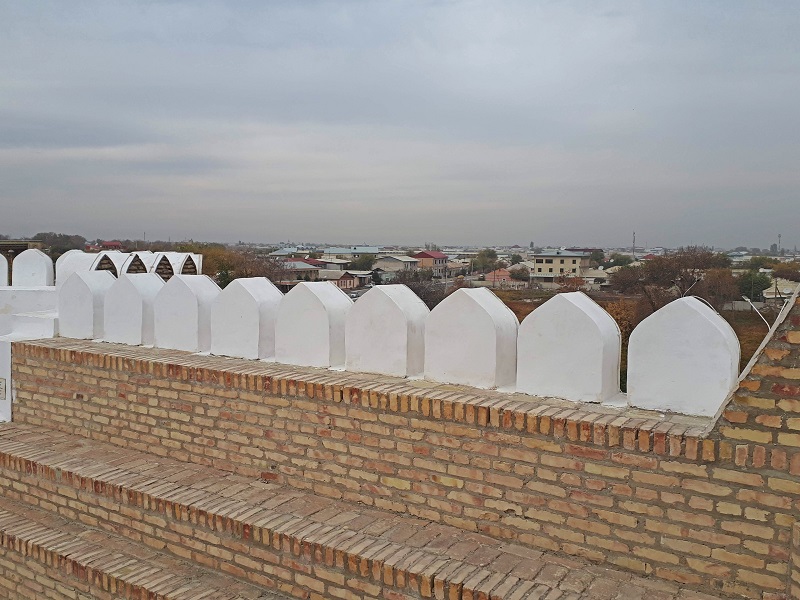
Inside the Ark
The Ark was essentially a sort of town within a town, as the royal court of the Emir of Bukhara was housed inside, which included a large number of servants and soldiers.
Within the Ark, you can explore the old mosque, throne room and a small museum that featuring some interesting artefacts, including lavishly adorned and calligraphed Qurans.
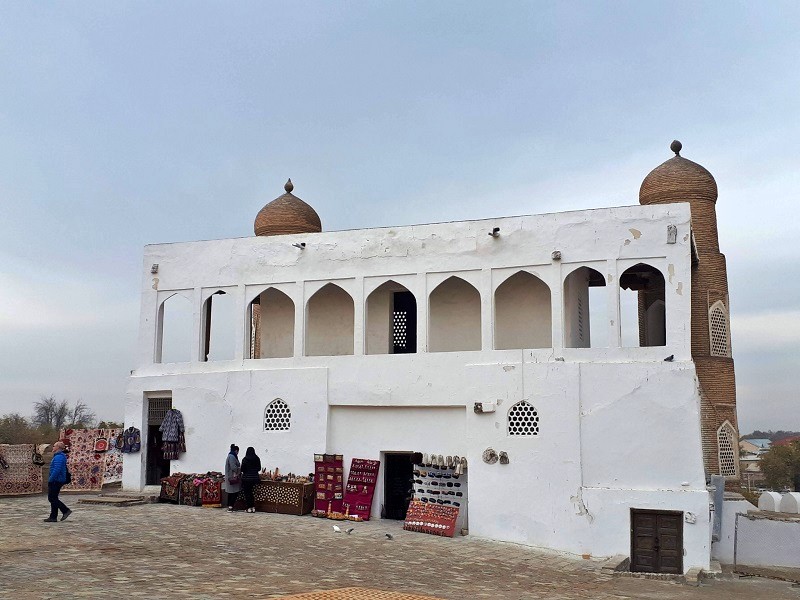
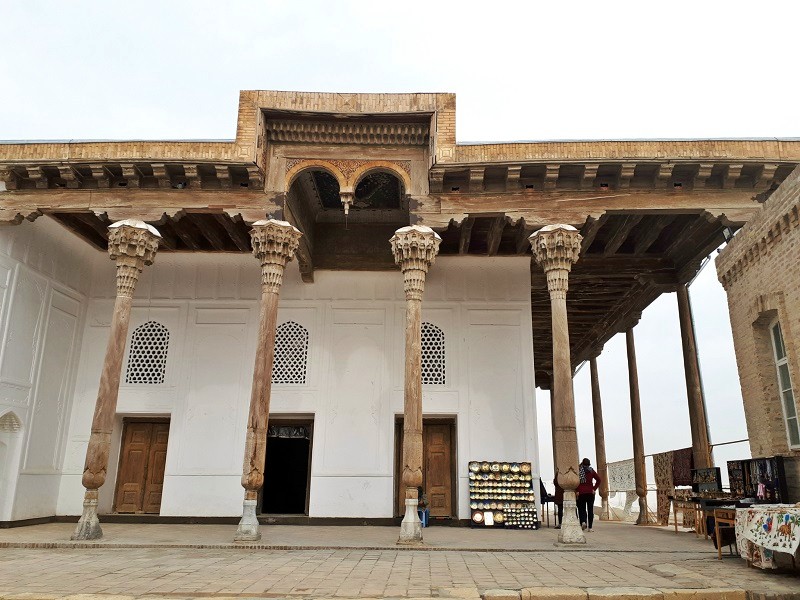
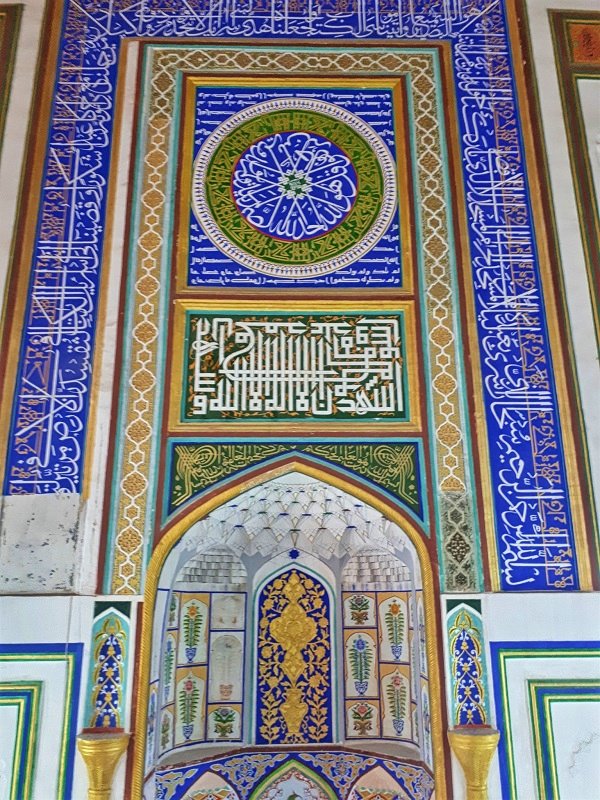
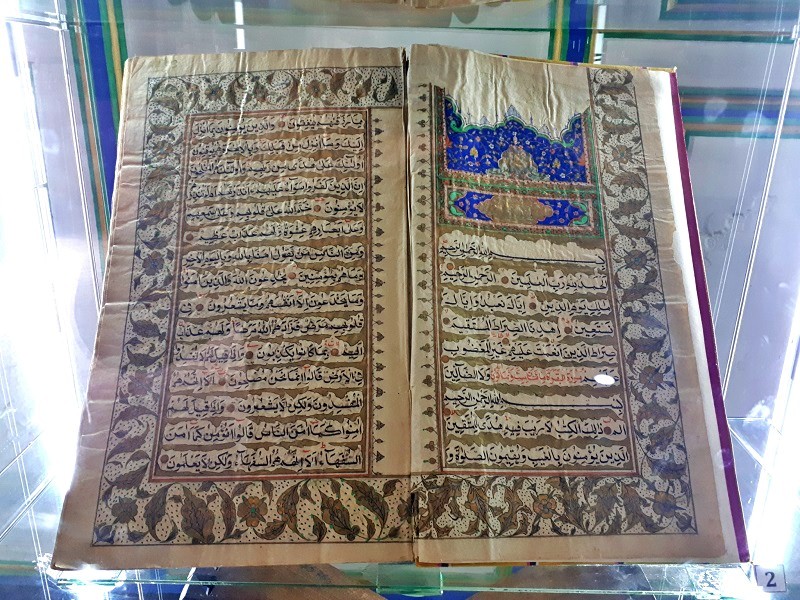
Meeting the Emir
Although my visit to the Ark of Bukhara was entirely peaceful, some other westerners were brought in here during entirely different circumstances throughout history.
In the 19th Century, British spies and diplomats tried to outmatch the Russian Empire in a secret battle for influence and control over Central Asia, which became known as ‘the Great Game’.
When British Colonel Charles Stoddart made a visit to Bukhara, he was tossed in a rodent-filled jail as the Emir was displeased he only brought a letter from the British Governor-General of India with him, and not one from Queen Victoria.
Although this was quite normal given that most of the British Great Game operations were masterminded from their Indian domain, the Emir didn’t see the Governor-General as a royal equal.
When Captain Arthur Conolly arrived in Bukhara to ask for Stoddart’s release, the Emir also threw Conolly in jail, thinking the British were secretly plotting with a rival Khanate to overthrow him.
Both British officers were executed in 1842 in front of the citadel.
Upon hearing the news back in Blighty, British relatives of both officers tasked a priest named Joseph Wolff to travel to Bukhara to verify the reports.
In the end, he was fortunate to avoid the same fate as Stoddart and Conolly, as the Emir apparently mistook him for a sort of jester in his clerical robes and couldn’t contain his laughter.
Back in the days, Bukhara was definitely not the friendliest of places in the world to visit.
Even if you already made it to Bukhara through some incredibly inhospitable desert terrain full of brigands, you never knew what kind of welcome would await you in town!


Bolo Hauz Mosque
Right opposite the Ark of Bukhara you can find the Bolo Hauz Mosque.
As you might expect, this mosque also has a rectangular pond (‘hauz’) situated in front of the building.
The Bolo Hauz Mosque was the preferred place of prayer for the Emirs of Bukhara and it’s certainly a striking place with its distinctive wooden columns and beautiful tilework.

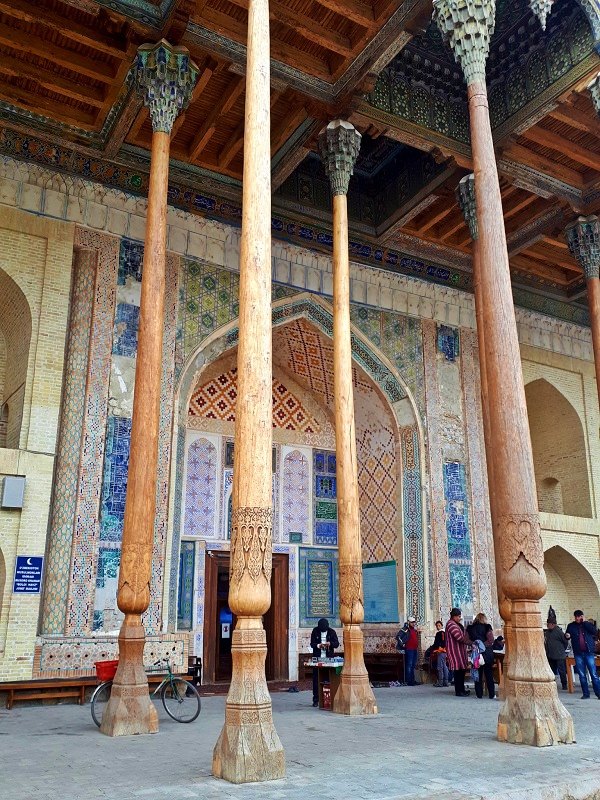
Other madrassas
Although by now I had seen all of Bukhara’s main sights, that didn’t mean there was nothing left to visit as there are a number of other places worth seeing a bit further out of the city centre.
One of these sights is the Qosh Madrassa located at the far western end of the city centre.
While the front iwan of this Bukhara madrassa is undeniably beautiful, a visit inside is not as interesting due to the overgrown courtyard and the building’s evident need for a renovation.
Directly opposite Qosh Madrassa you’ll come across yet another stunning madrassa, known as the Abdullah Khan Madrassa.
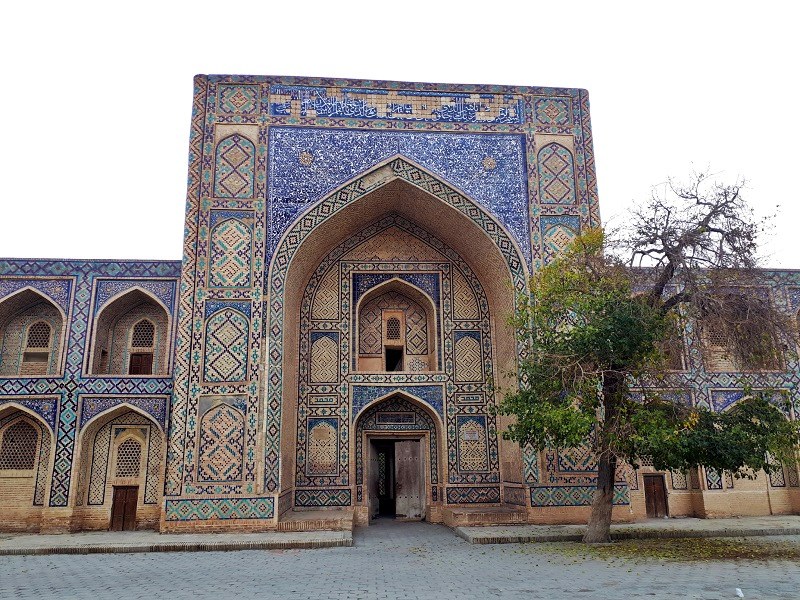
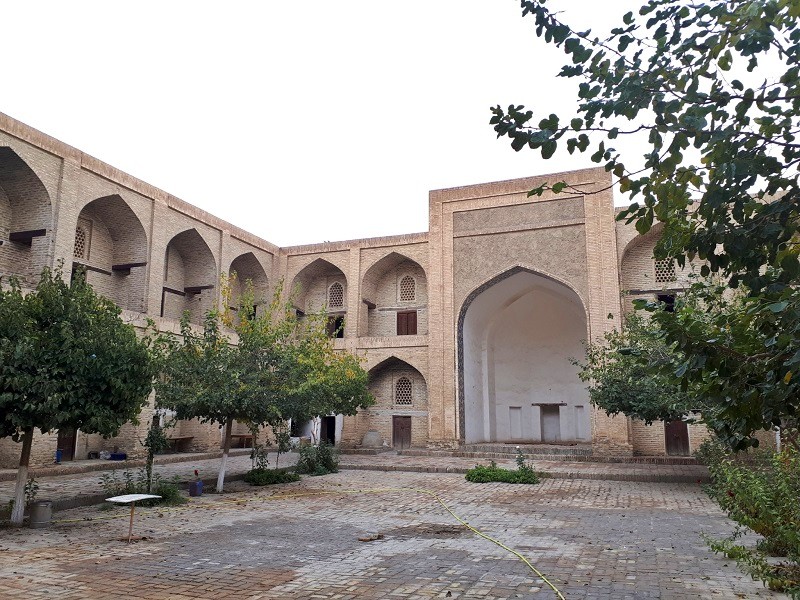
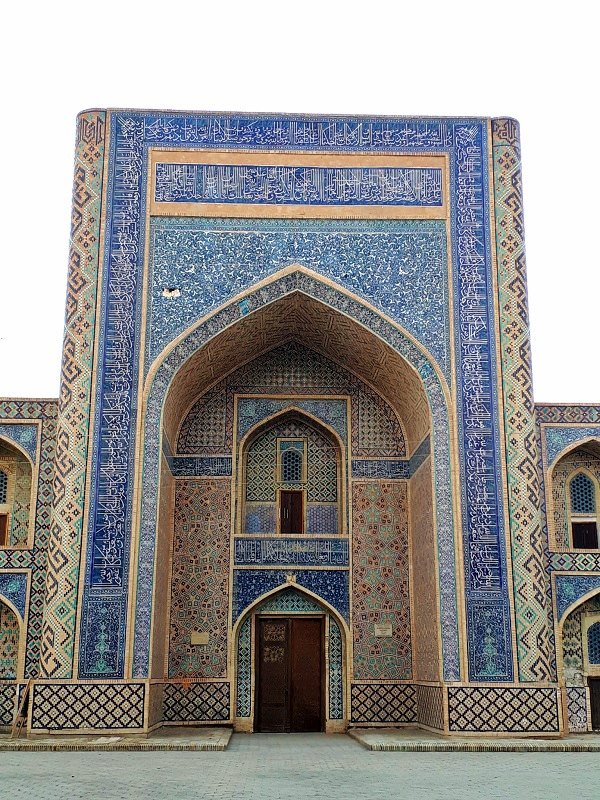

Park
After taking a quick look on the map I realised that I was near a large park, so I decided to take a stroll there.
This expanse of urban greenery, known as the Samonids Recreation Park, turned out to be a highly pleasant surprise and provided a refreshing change of scenery amidst all the visits to the mosques and madrassas of Bukhara.
Inside the park, you’ll come across the 10th-century Ismail Samani Mausoleum, which serves as the final resting place of a powerful emir from the Samanid Dynasty.
The Samonids Recreation Park also features a small fun fair, which makes it a great destination in Bukhara for those who are travelling with children.
Even I couldn’t resist taking a ride on the rickety Ferris wheel, which offered some splendid views over the city of Bukhara and its major landmarks.

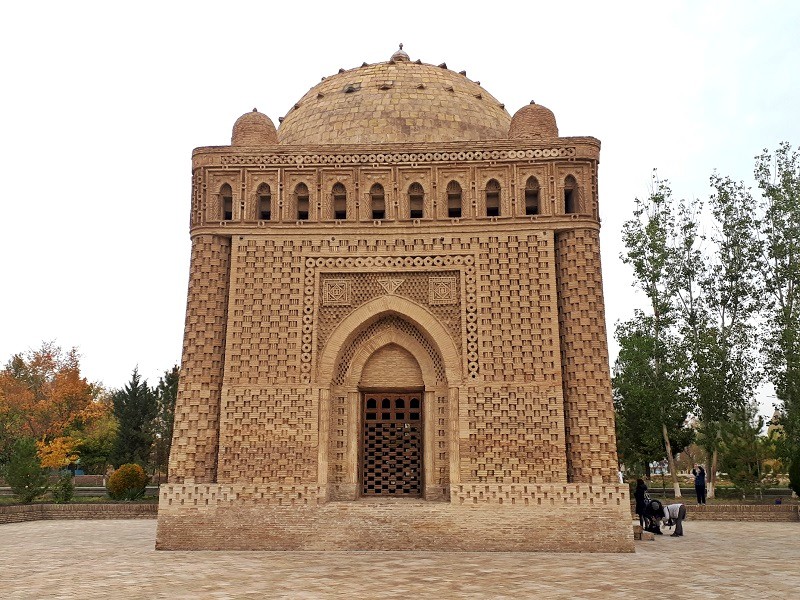







Dinner
From the park, I walked back along Bukhara’s beautiful sights to my favourite dining spot along the Lyabi-Hauz pool.
For dinner I ordered some shashlik and the meat was mouthwatering succulent.
After dinner, I lingered for a while longer with a beer or two to absorb the beautiful views over the pond, the historic buildings and the autumn foliage of the trees.
Again, there were some cute cats keeping me company.
Although the sights of Bukhara were perhaps not as spectacular as those in Samarkand, I ended up having an amazing visit during which I came to love the city’s unique historic charm and special atmosphere.


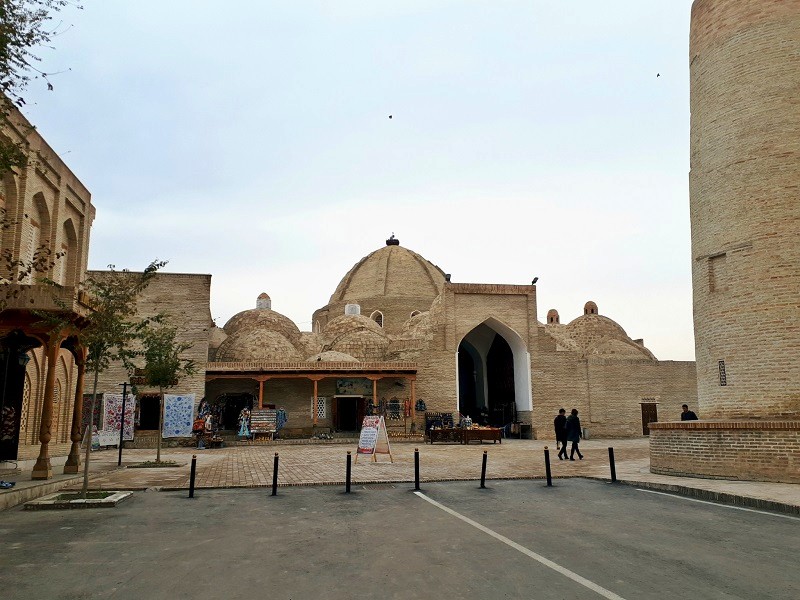
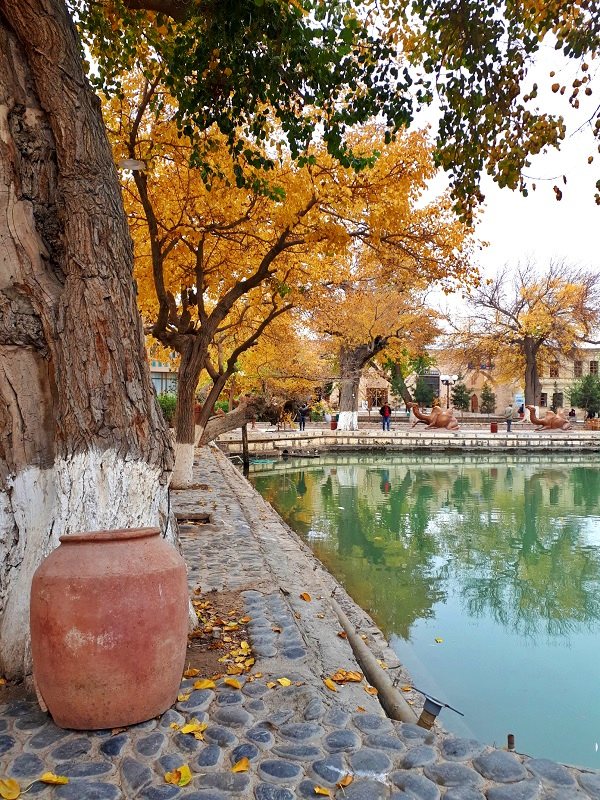

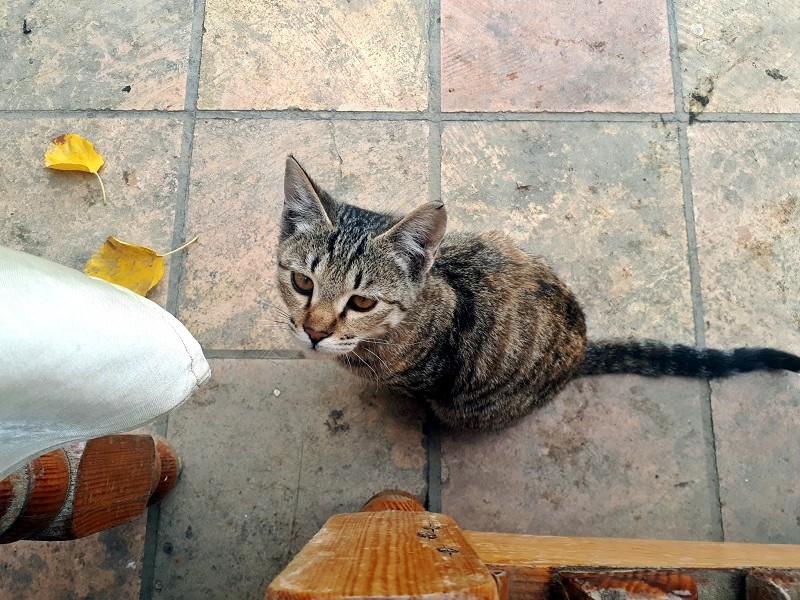


Conclusion
It’s a must to include a visit to Bukhara on your Uzbekistan itinerary as there are some fascinating historic sights to explore in this ancient Silk Road city.
The stunning Kalon Mosque and its 12th century minaret are perhaps the most impressive sights in Bukhara, although the numerous madrassas and the impressive fortifications of the Ark are also well-worth exploring.
Although the sights of Bukhara might lack the grandeur of those in Samarkand, the city’s unique historic atmosphere makes up for this.
Walking through Bukhara really feels like you are stepping back in time.
The pedestrian alleyways, the dirt streets, bazaars, the uniform buildings, the slightly decayed madrassas, everything just blends perfectly together.
It was simply an absolute delight to stroll around Bukhara and to admire all the fantastic historic sights this city has to offer.
Trip report index
This article is part of the ‘From Uzbekistan With Plov‘ trip report, which consists of the following chapters:
1. Review: Prietenia Night Train Bucharest to Chisinau
2. Chisinau Guide: A Visit to Moldova’s Capital
3. Istanbul Ataturk Airport and the Turkish Airlines Lounge
4. Review: Turkish Airlines Business Class Airbus A330
5. Tashkent Travels: A Day in the Capital of Uzbekistan
6. Tashkent to Samarkand by Uzbekistan Railways ‘Shark’ Train
7. Samarkand Visit Guide: Travelling Through Silk Road Splendour
8. Review: Afrosiyob High-Speed Train Samarkand to Bukhara
9. Bukhara: Exploring Unique Historic Sights and Timeless Charm (current chapter)
10. Bukhara to Khiva by Train: My Travel Experience
11. Khiva: Uzbekistan’s Unique Desert Oasis City
12. On a Night Train Across Uzbekistan: From Urgench to Tashkent
13. Guide: How to Travel From Tashkent to Shymkent
14. Shymkent: The Gateway to Southern Kazakhstan
15. Sukhoi Superjet: Flying Russia’s Homemade Plane

